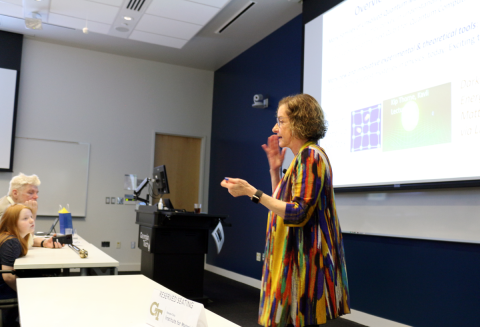
Over 100 in-person and virtual attendees gathered at Georgia Tech on April 11th and 12th for the Symposium on Materials Innovation, and 2022 Brumley D. Pritchett Lecture, jointly hosted by the School of Materials Science and Engineering and the Institute for Materials. This two-day event featured multiple faculty lectures, two guest Keynote Speakers, and Dr. Laura Greene, member of the President’s Council of Advisors on Science and Technology (PCAST), and the 2022 Pritchett Lecturer.
The opening day of the symposium covered sustainability and circular economies for materials production and reuse, as well as electronic, and energy materials. The morning kicked-off with the event’s first keynote speaker, Dr. Nag Patibandla from Applied Materials presenting, Materials Engineering Innovations for Display and Optics for AR/VR Devices. Following the opening keynote, faculty from across the materials research spectrum gave attendees an overview of research in lithiuum ion batteries, photovoltaics, materials for clean energy & water, renewable energy, and nanomaterials.
The Brumley D. Pritchett Lecture closed the lecture portion of the day. The lecture featured Dr. Laura Greene, the chief scientist at the National High Magnetic Field Laboratory, and the Marie Krafft Professor of Physics at Florida State University. Dr. Greene’s research centers on quantum materials, focusing on fundamental studies utilizing novel materials growth with planar tunneling and point contact electron spectroscopies to elucidate the mechanisms of unconventional superconductivity.
In her presentation, The Dark Energy of Quantum Materials, Greene spoke on correlated electron problems that remain largely unsolved; with one stunning success being Bardeen-Cooper-Schrieffer (BCS) electron-phonon mediated “conventional” superconductivity. Greene touched upon the many families of superconductors that are “unconventional” including the high-Tc cuprates, iron-based, and heavy fermion superconductors. These materials are disparate in many properties but display similarities in their fundamental properties. These topics were presented using an analogy to stress how they remain among the greatest unsolved problems in physics today.
The day was capped by a reception in the Marcus Nanotechnology Building Atrium, held in tandem with a student research posters session and tours of the Advanced Manufacturing Pilot Facility and the Materials Characterization Facility for interested attendees.
The second day of the Symposium focused on functional and quantum materials and characterization infrastructure at Georgia Tech to accelerate materials innovation. Faculty and research engineers touched on topics from meta and ferrroic materials to materials for modular and scalable micro and nano device engineering.
Day two also featured the event’s second keynote speaker, Dr. David D. Awschalom; Liew Family Professor and Vice Dean for Research of the Pritzker School for Molecular Engineering at the University of Chicago, a Senior Scientist at Argonne National Laboratory, and Founding Director of the Chicago Quantum Exchange. Awschalom’s lecture, The Quantum Revolution: Materials for New Technologies, touched on the ways in which new methods of computing, communication and measurement are being developed by researchers utilizing quantum phenomena such as entanglement, superposition and interference.
About The Brumley D. Pritchett Lecture
The Brumley D. Pritchett Lecture Series was established in the School of Polymer, Textile & Fiber Engineering (now Materials Science and Engineering) in 2006 as a memorial to the late Col. Brumley D. Pritchett. He received his bachelor's degree in textile engineering from the Georgia Institute of Technology in 1930, graduating with an award for superior achievement in his major. While at Georgia Tech, he was instrumental in the founding of the Phi Psi Textile Honors Fraternity and was a member of Phi Sigma Kappa. After graduation, he worked briefly with Dundee Mills before assuming management duties at Eagle and Phoenix Mills in Columbus, Georgia. He joined the United States Army in 1940 and served in the Pacific during World War II. Upon leaving the army, he returned to Eagle and Phoenix Mills as superintendent. Later, he joined Steel Heddle Manufacturing Company as a sales engineer and consultant, retiring in 1972. He was elected to membership in the College of Engineering Hall of Fame at Georgia Tech in 2002.